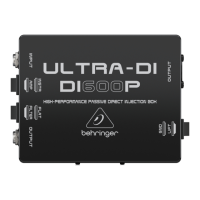2 3
ULTRA-DI DI600P ULTRA-DI DI600P
(1) Use the INPUT (¼" TS) connector for connecting signal sources.
(2) OUTPUT (¼" TS). This is the unbalanced parallel output.
Connect it to the input of your backline or monitor amplier.
Because the connectors (1) and (2) are wired in parallel,
the OUTPUT connector can be used both as an input and as a
direct unbalanced output of the INPUT signal. For the latter,
you can for example connect output with the input
of a monitor amplier.
(3) OUTPUT (XLR): This is the balanced mic-level output.
Use a high-quality balanced microphone cable
to establish connection.
(4) Using the GND LIFT (ground lift) switch, you can fully separate
input and output grounding. Depending on how the equipment
to which your DI600P is connected is grounded, using the GND
LIFT switch lets you lower hum noise or ground loops. When
the GND LIFT switch is in LIFT position, the ground connection
is interrupted.
(5) The INST/AMP attenuation switch (30 dB) increases the
operating range of the DI600P considerably, from low signal
levels of a high-impedance mic or a guitar (INST), all the way to
speaker connectors of a guitar amplier (AMP).
(6) Switchable FILTER for guitar applications (7.5 kHz, -3 dB).
The SERIAL NUMBER of the DI600P is located at the bottom.
Applications
2.1 Connecting an instrument signal
Fig. 2: Guitar DI-box guitar amp/mixer
This illustration shows the standard application of a DI-box.
The signal feeding the amplier remains unchanged; it is simply
taken and routed into the amp. The low-impedance balanced signal
is forwarded to the mic input of the mixing console. This application
has its advantages particularly with bass guitars, because very few
microphones can linearly transmit bass frequencies with high signal
levels. If you are using eects, insert the DI600P after the eects
device, so that you can monitor the eects via the PA system
or the recording as well.
Input
Output
Instrument Input Microphone Input
Out

